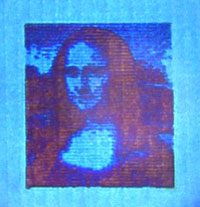A color laser printer with an amazing 127,000 dots per inch resolution
December 17, 2015

A laser-printed microscopic image of Mona Lisa 50 micrometers long, less than one pixel on an iPhone Retina display (credit: Technical University of Denmark)
A new laser-printing technology allows for printing high-resolution data and color images at the unprecedented resolution of 127,000 dots per inch (DPI) and with a speed of 1 nanosecond per pixel — developed by researchers at Technical University of Denmark’s DTU Nanotech and DTU Fotonik.
At that extreme resolution, images can be printed on the microscale. This patented method uses special plasmonic metasurfaces coated with 20 nanometers of aluminum. When a laser pulse heats each nanocolumn (up to 1,500°C for a few nanoseconds), it melts and is deformed.
The intensity of the laser beam heating controls the amount of deformation, which determines which color are printed. Low-intensity laser pulses lead to a minor deformation of the nanocolumn, resulting in blue and purple hue reflections. Stronger laser pulses create a larger deformation, which leads to reflection from the nanocolumn at longer wavelength orange and yellow hue.
According to Professor Anders Kristensen, it’s also possible to save data invisible to the naked eye with this technology. “This includes serial numbers or bar codes of products and other information. The technology can also be used to combat fraud and forgery, as the products will be labeled in way that makes them very difficult to reproduce. It will be easier to determine whether the product is an original or a copy.”
The new laser printing technology can also be used on a larger scale to personalize products such as mobile phones with unique decorations, names, etc. and for marking parts for cars, such as instrument panels and buttons. The scientists hope to eventually replace conventional laser printers.
Abstract of Plasmonic colour laser printing
Colour generation by plasmonic nanostructures and metasurfaces has several advantages over dye technology: reduced pixel area, sub-wavelength resolution and the production of bright and non-fading colours. However, plasmonic colour patterns need to be pre-designed and printed either by e-beam lithography (EBL) or focused ion beam (FIB), both expensive and not scalable processes that are not suitable for post-processing customization. Here we show a method of colour printing on nanoimprinted plasmonic metasurfaces using laser post-writing. Laser pulses induce transient local heat generation that leads to melting and reshaping of the imprinted nanostructures. Depending on the laser pulse energy density, different surface morphologies that support different plasmonic resonances leading to different colour appearances can be created. Using this technique we can print all primary colours with a speed of 1 ns per pixel, resolution up to 127,000 dots per inch (DPI) and power consumption down to 0.3 nJ per pixel.